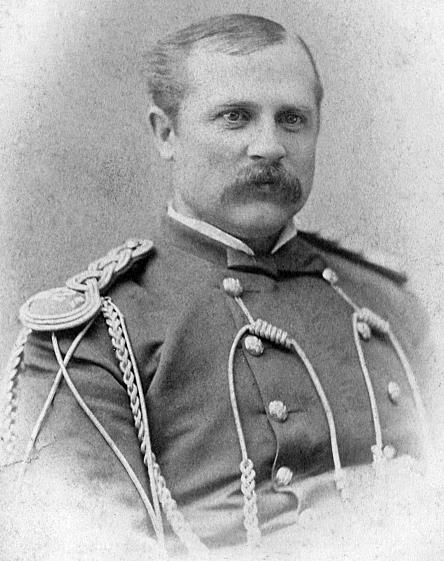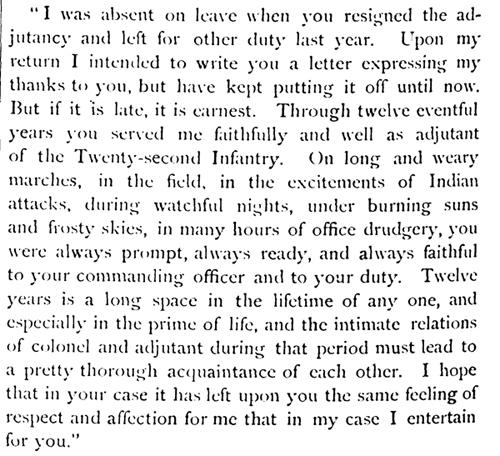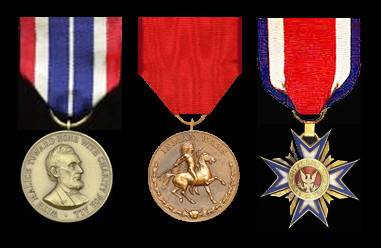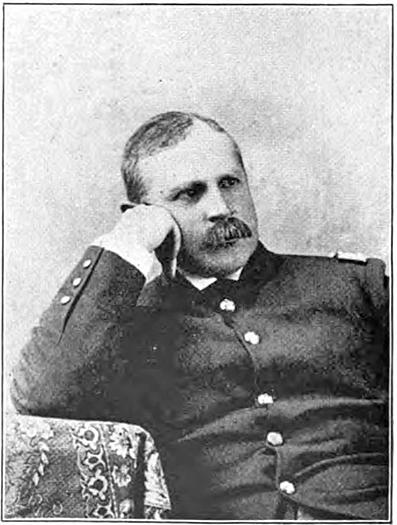![]() 1st Battalion 22nd Infantry
1st Battalion 22nd Infantry ![]()
Hiram H. Ketchum
22nd Infantry 1866-1898

1st Lieutenant Hiram H. Ketchum 22nd Infantry, photographed in 1876
Note the "22" on his shoulder knot, next to which is the single silver bar indicating 1st LT
Hiram Henry Ketchum was born on February 14, 1844 in Ontario, Canada.
At some time he moved to New
York, and at the age of eighteen he enlisted as a Private in
Company K of the
16th New York Volunteer Infantry, on September 20, 1861. The 16th
N.Y.V.I. stood out on the battlefield
because they wore wide brimmed straw hats instead of the normal
forage caps or kepis. While with the 16th
Ketchum took part in the battles of West Point, Gaines Mill,
Glendale, and Crampton's Pass in 1862. He was present
at the battle of Antietam, though his regiment was held in
reserve and did not see action. On September 29, 1862
Ketchum received an honorable discharge from the 16th N.Y.V.I.
On September 10, 1864 Ketchum
enlisted as a Private in Company I of the 1st New York Volunteer
Engineers,
joining his Company at their station in South Carolina. His
Company served in MG John Hatch's expedition up the
Broad River and the subsequent engagement at Honey Hill, and in
the later battle of Deveaux's Neck in South Carolina.
On May 30, 1865 he was honorably discharged from the 1st N.Y.V.E.
On February 23, 1866 Ketchum
received a commission as a 2nd Lieutenant in the 2nd Battalion of
the US 13th Infantry,
a position which he accepted on April 30. June of that year found
Ketchum detached from 2nd Battalion and camped
with Company C of the 13th Infantry, building a new fort in the
Dakota Territory, at the point where the Missouri and
Yellowstone Rivers met. The camp was named Fort Buford, and
attacks by hostile Indians began against it the second day
of its establishment. Ketchum and Company C's Commander, Captain
William G. Rankin were the only officers at Buford,
in command of about seventy enlisted men. On July 28, 1866, the
garrison at Buford was re-designated as
Company C 22nd Infantry, with the official change of the 2nd
Battalion of the 13th Infantry to the 22nd Infantry Regiment
coming on September 21 of that year.
Ketchum thus became engaged in the first combat actions of the 22nd Infantry since the War of 1812.
Fort Buford was attacked by the
Sioux almost daily during the summer months of 1866 and into the
fall. Parties sent out
to cut logs to build the fort were frequently driven back to the
fort where battles ensued, often lasting for hours. In December
three civilian wood cutters were killed by Indians near the
Yellowstone river, and Lieutenant Ketchum led a force of 60 men,
or nearly the entire garrison, in an attack which drove off the
hostiles, his detachment suffering a few wounded in the
engagement.
The fort was surrounded and
besieged by the Indians throughout the winter of 1866-1867.
Denied water from the rivers,
the little garrison had to dig wells within their encampment. Cut
off from the outside world, a rumor began that the small camp
was wiped out by the Sioux, with Rankin, Ketchum and all the
Soldiers killed, and several major newspapers back in the East
ran the story as if it were fact. Even in April 1867, when Rankin
himself appeared in person to deny the story, several newspapers
accused the Army and the government in Washington of covering up
the "massacre".
On July 31, 1867 Ketchum was
promoted to First Lieutenant. On March 1, 1869 he was appointed
the Regimental Adjutant
of the 22nd Infantry, a position he would hold until October 1,
1881. Ketchum was part of the Third Yellowstone Expedition
of 1873. The expedition force was made up of fourteen Companies
of Infantry (which included five Companies
of the 22nd Infantry) and ten Companies of Cavalry. The Cavalry
was the 7th, commanded by Lieutenant Colonel George Custer.
The entire expedition force was under the command of Colonel
David Stanley, the Commander of the 22nd Infantry.
Ketchum was accompanying the
advance guard of Custer and his Cavalry, during a series of
engagements with a large force
of some 300 to 400 Sioux, over a period lasting seven days in
August of 1873. On August 11, Ketchum had his horse shot out
from under him during a desperate fight between the Cavalry and
the hostiles, during which losses were incurred on both sides.
For his courage that day he received a Brevet promotion to
Captain. At a time when the only decoration in the US Army
was the Medal of Honor, a Brevet promotion was a way of
recognizing heroism for an act which required less than that
for the Medal of Honor. A Brevetted officer would be accorded
most of the privileges of his Brevet rank, with the exception
of the pay scale, though officially he would still be carried in
the records at his lesser rank. The Brevet would be noted in his
record,
much the same as decorations would be noted in today's records.
In 1881, upon relinquishing the
position of Adjutant, Ketchum was assigned to Company E 22nd
Infantry. On July 20, 1882
he was promoted to Captain in the Regular Army and given command
of Company H 22nd Infantry. He would hold this position
until his retirement. In November 1890 he was given orders to
move his Company from Fort Keogh, Montana to Fort Abraham
Lincoln,
North Dakota, as troubles with the Indians during the Ghost Dance
period of 1890-1891 brought the Indian Campaigns to a final
close.
As the troubles subsided, he brought Company H back to Fort
Keogh. The official history of the Regiment records the
following,
as what was probably the last major exercise of his career:
"August
25,1892.—Company H, Twenty-second Infantry, Capt. H.H.
Ketchum, commanding, left Fort Keogh, en route to
Camp Merritt, near Tongue River Agency, Mont., for a tour of duty
there, and to relieve company C, Twenty-second Infantry,
from duty at that camp. Arrived August 31. Distance marched,
about 90 miles."
During the month of June, 1896,
Ketchum brought his Company with the Regiment to its new duty
station at Fort Crook, Nebraska.
In April of 1898 the 22nd Infantry left Fort Crook for Tampa,
Florida, to begin its excursion to Cuba in the Spanish-American
War.
Hiram H. Ketchum did not go with the Regiment, as, in poor
health, he was promoted to Major on April 26, 1898 and retired
from the Army.
He died a few months later, on August 12, 1898. He had served 32
years in the 22nd Infantry. His obituary in the New York Times
stated that he died at his summer home in Avon-by-the-Sea, New
Jersey. The obit further recorded that he had "arrived at
Avon recently
with his family, going there for his health from his home at
Canandiagua, N.Y." He was 55 years old.
In 1882 Colonel D.S. Stanley,
commanding the 22nd Infantry, and under whom Hiram H. Ketchum had
been the
Adjutant of the Regiment for twelve years, wrote the following
letter expressing his admiration for Ketchum's service
as Adjutant of the 22nd Infantry:
 ¹
¹

Above: At the top left is the signature
of Hiram H. Ketchum as 1st Lieutenant of the 22nd Infantry
and Adjutant of the Regiment on the monthly Return of the 22nd
Infantry for the
month of March 1874 at Fort Sully, Dakota Territory. At the
bottom right is the
signature of Colonel David S. Stanley as Commander of the
Regiment. The date
of April 11, 1874 is the actual date that Stanley signed the
Return. Except for
Stanley's signature all of the handwriting is by Ketchum, who as
Adjutant had to
handwrite each monthly Return in the days before the invention of
the typewriter.
The following biography of Hiram H. Ketchum was written in 1892:
CAPTAIN H. H. KETCHUM
(Twenty-second Infantry) was a son of Henry and Mary A. Ketchum,
who were born in Vermont
in 1806. He received an academic education. Enlisted in 1861 in
the Sixteenth New York Volunteers, at the age of seventeen.
He participated in the Peninsula campaign of the Army of the
Potomac, and was slightly wounded at Gaines' Mill. He continued
in the field with that army through the Maryland campaign, and
was discharged after the battle of Antietam, broken down in
health,
owing to his youth. When he regained his health again he enlisted
in the First New York Engineers, and was mustered out of service
June 1, 1865.
He was appointed second
lieutenant in the Thirteenth Infantry on the 23d of February,
1866, and served at Fort Buford during the
summer of 1866, fighting Indians almost daily during that time. He
then served at Fort Dakota until July, 1867. He was promoted
first lieutenant and served at Fort Sully until 1874, when he was
appointed adjutant Twenty-second Infantry, by General Stanley.
He served in that capacity over twelve years.
Lieutenant Ketchum was
adjutant-general of the Yellowstone expeditions under General
Stanley during the years 1871 and 1873;
had his horse killed under him in an Indian fight in August,
1873, at the mouth of Big Horn River, Montana, while serving with
General Custer in the capacity of aide. General Stanley, in a
report to the adjutant-general of the army, says, " I have
the honor
to state that on the 11th of August, 1873, the troops under my
command had a severe engagement with the Sioux Indians
on the Yellowstone River, near the mouth of the Big Horn. The
principal fight was between seven troops of the Seventh Cavalry,
commanded by Lieutenant-Colonel G. A. Custer, in repelling the
attack of at least fifteen hundred Sioux warriors. First
Lieutenant
H. H. Ketchum, adjutant of the Twenty-second Infantry, was in the
thickest of the fight and had his horse killed under him. His
services
were gallant and important." General Custer, in a report to
General Stanley, says, " I desire to commend to the brevet
major-general
commanding First Lieutenant H. H. Ketchum, adjutant Twenty-second
Infantry, acting assistant adjutant-general of the expedition,
but temporarily serving with me, who rendered me great assistance
in transmitting my orders on the battlefield. He had his horse
killed under him, and I had my horse shot at the same time."
In 1874 Lieutenant Kctchum was
ordered with his regiment to the Department of the Lakes. In 1877
he was adjutant-general
of the troops serving under the command of Lieutenant-Colonel E.
S. Otis, Twenty-second Infantry, in quelling riots in
Pennsylvania. He was ordered to Texas with his regiment in the
spring of 1879, and served at Fort McKavett and Fort Clark
until the fall of 1881, when he was ordered on recruiting service
for two years. He rejoined his regiment in the fall of 1883,
at Fort Lewis, Colorado. He was ordered with his company to quell
troubles with the Utes, Navajos, and settlers on San Juan River,
Colorado, in 1883-85. In 1888 he was ordered with his regiment to
Fort Keogh, Montana, and participated in the Sioux campaign of
1890-91.
Captain Ketchum has been
recommended for brevet rank for Indian campaigns, and has been
favorably mentioned
by department inspectors to the inspector-general of the army for
efficiency as company commander. ²

Hiram H. Ketchum's decorations
Left to right: Civil War
Campaign Medal, Indian Wars Campaign Medal,
Military Order of the Loyal Legion of the United States

1st Lieutenant Hiram H. Ketchum
Photo from Companions of
the Military Order of the Loyal Legion of the United States
L.R. Hamersly Co. New Yok, 1901
Hiram H. Ketchum is listed in
the official Military Order of the Loyal Legion of the United
States (MOLLUS) record
as Major, 22nd Infantry USA and an original member (Companion)
of the Military Order of the Loyal Legion of the United States.
Burial:
Forest Lawn Cemetery
Buffalo
Erie County
New York, USA
Plot: Section T
|
Left: The grave monument of Major H.H. Ketchum Above: The lower part of the
monument. HIRAM HENRY KETCHUM |
Grave photos from the Find A Grave website
¹ OFFICERS OF THE ARMY AND NAVY (REGULAR) WHO
SERVED IN THE CIVIL WAR
Edited by Major William H. Powell U.S. Army (22nd Infantry) and
Medical-Director Edward Shippen U.S. Navy
Publisher L.R. Hamersly & Co. Philadelphia. PA 1892 pp 230
² Ibid
Additional Sources:
Official US Army Registers 1866-1898
History of the Twenty-second US Infantry 1904
Military Order of the Loyal Legion of the United States
New York Times August 13, 1898
New York State Military Museum and Veterans Research Center
1st New York Volunteer Engineers
Home | Photos | Battles & History | Current |
Rosters & Reports | Medal of Honor | Killed
in Action |
Personnel Locator | Commanders | Station
List | Campaigns |
Honors | Insignia & Memorabilia | 4-42
Artillery | Taps |
What's New | Editorial | Links |